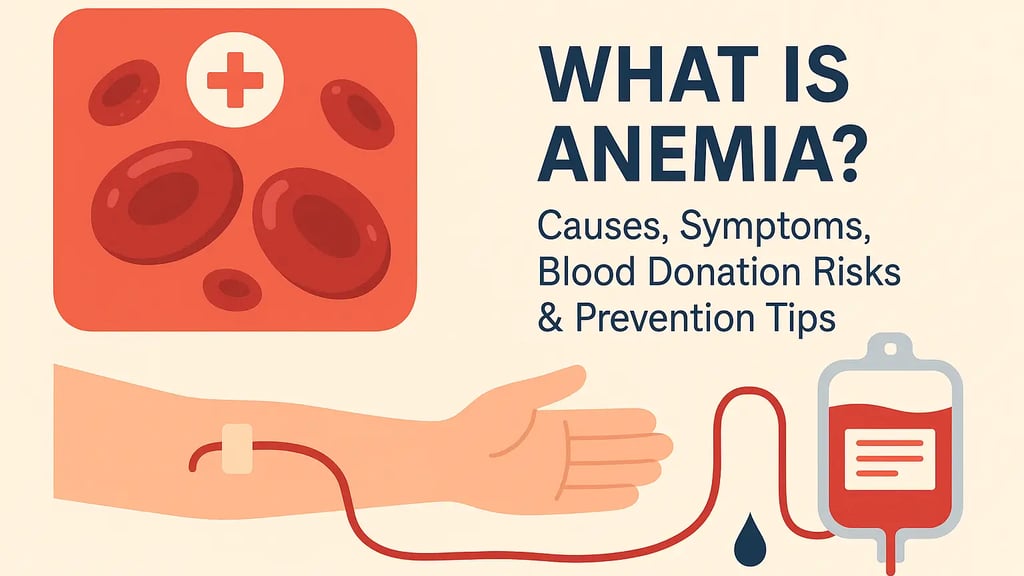What is Anemia? Causes, Symptoms, Blood Donation Risks & Prevention Tips
Discover what is anemia , its causes, symptoms, and whether blood donation causes anemia. Learn expert tips and advice to prevent anemia and donate blood safely.


🩸 What Is Anemia? A Complete Guide to the Condition
Anemia is a common blood disorder that occurs when your body lacks enough healthy red blood cells or hemoglobin to transport oxygen effectively to tissues. As a result, you may experience fatigue, weakness, and poor concentration. It’s not a single disease, but a group of conditions—each with unique causes and health impacts.
🩺 Common Types of Anemia
Iron-deficiency anemia: Caused by insufficient iron, often due to poor diet or blood loss.
Vitamin B12 deficiency anemia: Results from a lack of B12 due to diet or absorption problems.
Folate deficiency anemia: Due to low folic acid intake, especially during pregnancy or poor nutrition.
🧬 Other Causes of Anemia
Chronic conditions such as kidney disease, inflammatory disorders, and cancer can also reduce red blood cell production. Genetics, certain medications, and autoimmune diseases may also play a role.
🚨 Symptoms of Anemia: What to Watch For
The signs of anemia vary depending on severity and type. Most commonly, people report:
Persistent fatigue and low energy
Pale or yellowish skin
Rapid heartbeat or palpitations
Dizziness or light-headedness
Difficulty concentrating
In severe cases, reduced oxygen delivery to the brain can impair memory and cognitive functions.
🩸 Blood Donation and Anemia: What Happens to Your Body?
Blood donation is a safe and life-saving act, but it naturally causes a temporary drop in hemoglobin levels. Here’s what typically happens:
✔️ Before Donation: Screening Process
You’ll be asked about your health, medications, lifestyle, and travel history. Your blood pressure, pulse, hemoglobin levels, and temperature are checked to ensure you're eligible.
✔️ During the Donation
Approximately 1 pint of blood is drawn using a sterile needle, a process that takes about 8–10 minutes. The body quickly replaces plasma volume, but red blood cell recovery can take a few weeks.
✔️ After Donation
Minor side effects may include fatigue, dizziness, or bruising. Staying hydrated, eating iron-rich foods, and resting are vital for recovery. These precautions help reduce the risk of post-donation anemia.
🔬 Does Donating Blood Cause Anemia? What Science Says
Several research studies have confirmed that occasional blood donation does not cause long-term anemia in healthy individuals. However, frequent donations without proper recovery can temporarily lower hemoglobin.
📊 Key Findings:
A study in Transfusion journal found most donors return to baseline hemoglobin within a few weeks.
Donating once or twice a year carries minimal risk.
Regular donors should follow the 8-week interval rule to avoid low iron levels.
💡 Guidelines by Health Authorities:
Men: Up to 6 donations per year
Women: Up to 4 donations per year
Always follow screening protocols to ensure you're not already anemic before donating.
🛡️ How to Prevent Anemia and Donate Blood Safely
Donating blood is safe if done responsibly. Here’s how to protect your health:
🥗 1. Eat a Nutrient-Rich Diet
Consume foods rich in:
Iron: Red meat, beans, lentils, spinach, tofu
Vitamin B12: Eggs, dairy, fish, fortified cereals
Folate: Leafy greens, citrus fruits, whole grains
👉 Pro Tip: Pair iron-rich foods with vitamin C (e.g., oranges, tomatoes) for better absorption.
💧 2. Stay Hydrated
Drink plenty of fluids before and after donation to maintain blood pressure and reduce dizziness.
👨⚕️ 3. Get Regular Health Checks
Monitor your hemoglobin and iron levels regularly. Consult a healthcare provider before becoming a frequent donor.
😌 4. Post-Donation Care
After donating:
Rest for 15–30 minutes
Eat a small snack or juice
Avoid strenuous exercise for the next 24 hours
By taking these steps, you can donate blood safely and help save lives—without putting your own health at risk.
✅ Final Thoughts
Anemia is a manageable condition with the right awareness, diet, and healthcare support. Occasional blood donation is generally safe, especially when combined with good nutrition and proper screening. Understanding the link between anemia and blood donation helps individuals contribute to society without compromising their well-being.
